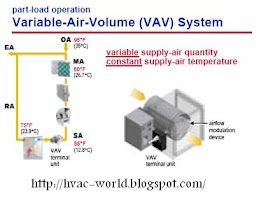New Buildings Institute. The result is stuffiness and discomfort. This affects the air distribution. Friction Rate Reduction Method. The procedure is as follows: 1.
Starting at the fan discharge, choose the larger duct size from among both of the following design limits : a. System is tolerant of inadequacies in duct design and installation because,. VAV duct mains , the EDR. Essentially a Variable Air Volume system allows a design engineer a way to zone large areas in workspaces such as office buildings and other places where there are large spaces that need heating and cooling or simply just cooling in rare cases.
The concept is simple but making it energy efficient. In pressure dependent systems , the volume of air supplied by the terminal unit varies depending upon the static pressure (SP) in the primary air duct. However, the airflow through the damper varies according to the SP in the main duct.
Fan flow is reduced in partial load periods, this will provide more energy saving and improved thermal comfort. Variable air volume boxes have several key components that work together to deliver the proper amount of treated air to one or more thermostatically controlled zones. The components include: A central air handling unit to force treated air through ducts to the space to be heated or cooled.
The most common set-up (for DDC) is, of course, usually the cheapest to install. The air volume works as a closed control loop, i. These days many designers want to comply with both Standard 62. Requirements from both standards have been incorporated into many building codes, and the minimum requirements of both standards must be met as prerequisites to LEED certification. A zone can be a single room or cluster of rooms with the same heat gain and heat loss characteristics. In critical spaces, designer must calculate supply, return and exhaust air under all conditions, and ensure air pressurization is maintained all the time.
Offers more precise temperature control as the fan speed varies depending on the temperature in the space. The compressor regulates the refrigerant flow to maintain a constant air temperature. This is a result of improvements in the terminal unit.
The volume of air delivered is based on the space conditions as sensed by a temperature sensor. Eliminates bucking: a characteristic of predecessor systems such as dual duct, multi- zone and terminal RHzone, and terminal RH. At off design conditions, the majority of the time, fan power is reduce i.
Imperial dimensions are converted to metric and rounded to the nearest millimeter. Room temperature is measured and controlled based on inducing room air into the diffuser core. Presented by David Szemborski and David Pich, this webinar focused on basic concepts and system benefits, construction and single diffuser application. Many different HVAC systems are available today, but most of the new designs utilize heated and cooled air as the medium for environmental control. As the HVAC loads change, the HVAC zone monitoring thermostat(s) signal a required adjustment to the amount of air being delivered to the space.
For example, in a cooling application, at higher loads, a higher volume of air would be delivered to the space. HVAC systems, like all systems in the building, do not function in isolation, but are part of an interactive system of components. Before addressing the design of the HVAC system , this chapter addresses several aspects of building design that influence the loads imposed on the HVAC system.
V Min: Design minimum (heating) flow rate incorporating Bldg Code required minimum outside air, determined by system designer. VVT (variable volume and temperature) is an economical, all-air zoned system that is ideal for many commercial jobs, especially at a time when there is so much design emphasis being placed on high quality air treatment, outdoor air ventilation, and room air circulation.

No comments:
Post a Comment
Note: only a member of this blog may post a comment.